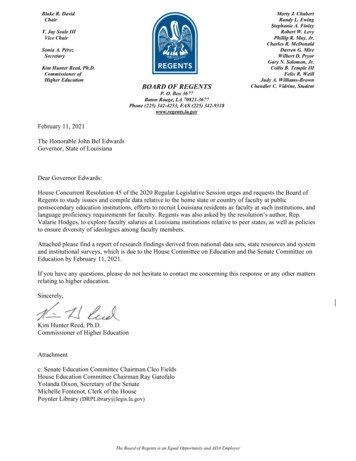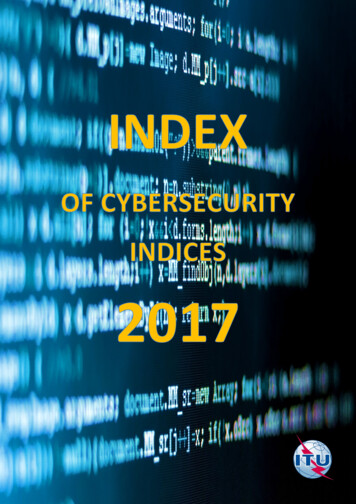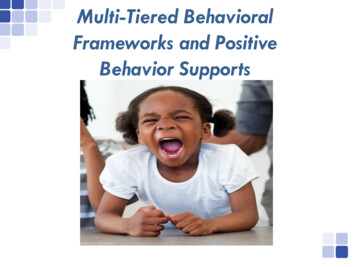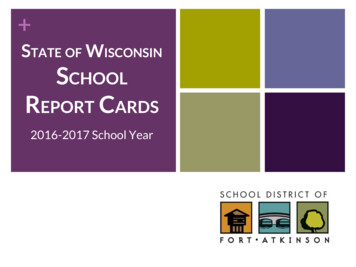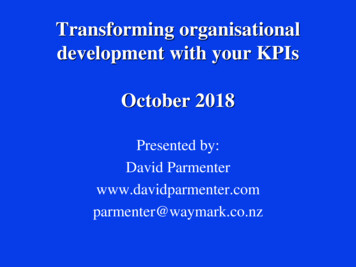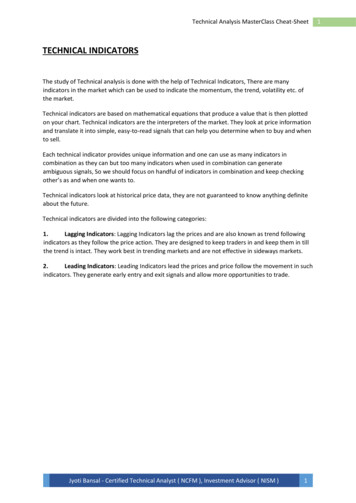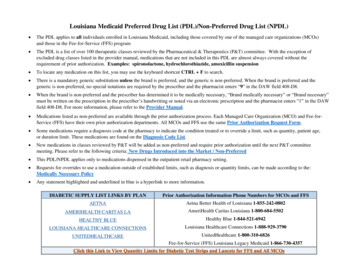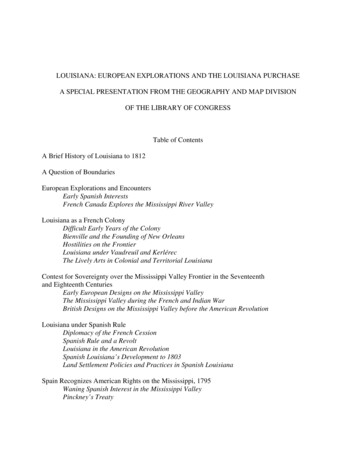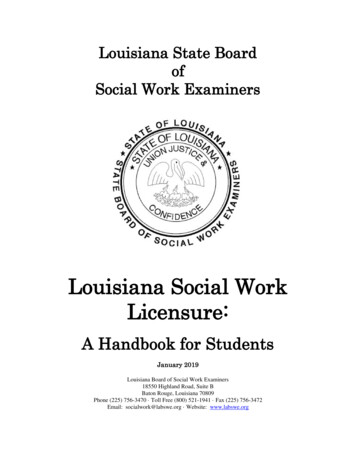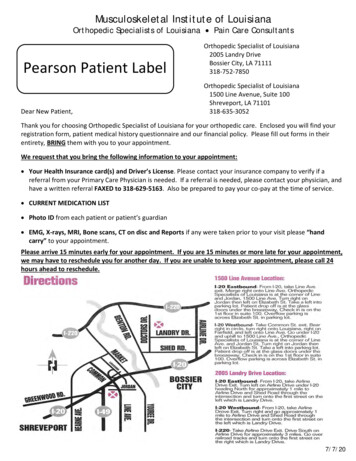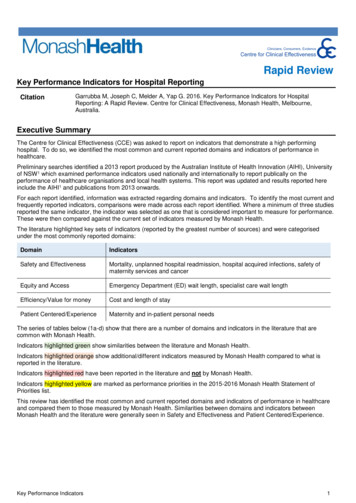
Transcription
Council of Chief State School OfficersState Consortium on Education LeadershipPERFORMANCEEXPECTATIONSand INDICATORSfor EDUCATION LEADERSAn ISLLC-Based Guide to Implementing Leader Standardsand a Companion Guide to theEducational Leadership Policy Standards: ISLLC 2008Council of Chief State School OfficersOne Massachusetts Avenue, NW, Suite 700Washington, DC 20001-1431www.ccsso.orgNancy M. Sanders, Ph.D.andKaren M. KearneyEditors2008
THE COUNCIL OF CHIEF STATE SCHOOL OFFICERSThe Council of Chief State School Officers (CCSSO) is a nonpartisan, nationwide, nonprofit organizationof public officials who head departments of elementary and secondary education in the states, theDistrict of Columbia, the Department of Defense Education Activity, and five U.S. extra-state jurisdictions. CCSSO provides leadership, advocacy, and technical assistance on major educational issues. TheCouncil seeks member consensus on major educational issues and expresses their views to civic andprofessional organizations, federal agencies, Congress, and the public.THE STATE CONSORTIUM ON EDUCATION LEADERSHIPThe State Consortium on Education Leadership (SCEL), convened by the Council of Chief State SchoolOfficers, brings state education agency (SEA) personnel together to share state policies/practices anddevelop needed resources for improving education leadership. Through this consortium, SEA representatives have requested assistance with improving education leadership at all levels particularly as ameans of improving low-performing districts and schools. Regular communication and meetings haveenabled this group to come to consensus on many issues, build their leadership capacity, and developtools and products for the field.PERFORMANCE EXPECTATIONS AND INDICATORS FOR EDUCATION LEADERSThe Performance Expectations and Indicators for Education Leaders were developed by members of SCELand funded by their state participation fees. We would like to thank the representatives of memberstates who contributed extensively to the development, writing, and national process of reviewing andediting this document.Additional acknowledgement to Kelly Hunter Design (www.khunterdesign.com) for design and toMarty Bush for editorial assistance.COUNCIL OF CHIEF STATE SCHOOL OFFICERSRick Melmer (South Dakota), PresidentElizabeth Burmaster (Wisconsin), Past PresidentT. Kenneth James (Arkansas), President-ElectGene Wilhoit, Executive DirectorCouncil of Chief State School OfficersOne Massachusetts Avenue, NW, Suite 700Washington, DC 20001-1431Phone (202) 336-7000 Fax (202) 408-8072www.ccsso.orgCopyright 2008 by the Council of Chief State School OfficersAll rights reserved.
Dear Colleagues,We are delighted to make available the Performance Expectations and Indicators for Education Leadersas an ISLLC-based guide to implementing leader standards and a companion guide to the EducationalLeadership Policy Standards: ISLLC 2008. The Performance Expectations and Indicators are a longawaited product of a national collaboration among state education agency (SEA) officials.Representatives from 24 states, the District of Columbia, and America Samoa provided SEA staff timeand resources to the development of this document. SEA contributors brought to the task a rich mix ofknowledge and experience from their leadership roles in schools, districts, and state-level policy arenas.They lead a variety of SEA activities such as administrator certification/licensure, accrediting andmonitoring preparation programs, administrator assessment and evaluation, and recruiting andtraining leaders in academies and other settings. They also develop and support innovative strategiesthat help recruit, train, support, and retain effective education leaders.Contributors generously shared products, resources, and exciting approaches to improving leadershipthat are underway in their states. As part of the process of writing this document, they also engagedhundreds of professionals and stakeholders in systematic reviews of draft content and language over atwo-year period. Reaction to this work has been uniformly positive. Administrators, university faculty,program providers, and others who have reviewed the document report that the PerformanceExpectations and Indicators have immediate applications in their work. The quality of this productreflects the contributors’ dedication and commitment to providing effective leadership, educationalexcellence, and equity for every student.Writing of the Performance Expectations and Indicators was carried out under the aegis of CCSSO’s StateConsortium on Education Leadership (SCEL). The contributors considered a wide array of options aboutwhat education leaders should know and do, now and in the future. They developed a truly nationalperspective on leadership expectations that transcends differences in state and local settings. Theychallenged each other to think deeply about research, practice, needs of future leaders, and howperformance descriptors could convey high expectations during a time of increasing accountability andother pressures on educators. They set high expectations for leaders that are attainable over timethrough careful career planning and quality professional development. The process and products of thiscollaboration also contributed to the creation of the Educational Leadership Policy Standards: ISLLC2008 (which updated the 1996 Interstate School Leaders Licensure Consortium Standards for SchoolLeaders) with other members of the National Policy Board for Educational Administration and informednew national assessments for certification/licensure. Given the consortium’s national representationand timeliness of the work, the Performance Expectations and Indicators serve as a guide toimplementing broad leadership policy standards.We are pleased to provide the Performance Expectations and Indicators as part of the Council’scontributions to the national dialogue and products to strengthen education leadership. Wecongratulate SEA contributors on their foresight in taking on this task and for their commitment toimproving education leadership in every state, district, and school, and most importantly, for everystudent in America.Sincerely,Nancy M. SandersCCSSO ConsultantDirector, State Consortium onEducation LeadershipKaren KearneyCCSSO ConsultantDirector of Leadership Initiatives,WestEd
Per formance Expectations and Indicators
TABLE OF CONTENTSPerformance Expectations and Indicators for Education LeadersIntroduction1Coherent Policy Systems to Support Quality Leadership, Effective Teaching, andStudent Learning2Structure of the Performance Expectations and Indicators7Important Characteristics of the Performance Expectations and Indicators10Summary12The Performance Expectations and IndicatorsPerformance Expectation 1: Vision, Mission, and Goals13Performance Expectation 2: Teaching and Learning16Performance Expectation 3: Managing Organizational Systems and Safety19Performance Expectation 4: Collaborating with Families and Stakeholders22Performance Expectation 5: Ethics and Integrity25Performance Expectation 6: The Education System28AppendicesAppendix A: Comparing ISLLC 1996 and the Performance Expectations and Indicators31Appendix B: Educational Leadership Policy Standards: ISLLC 200832Appendix C: Overview of the Performance Expectations and Elements34Per formance Expectations and Indicators
Per formance Expectations and Indicators
PERFORMANCE EXPECTATIONS AND INDICATORS FOREDUCATION LEADERSINTRODUCTION“The main purpose ofthe leader performanceexpectations is toprovide a resource forpolicymakers andeducators in states,districts, and programsto analyze and prioritizeexpectations of educationleaders in various rolesand at strategic stagesin their careers.”Expectations about the performance of education leaders have changedand expanded considerably in the past decade, extending far beyondtraditional definitions of administrative roles. Responsibilities of educationleaders now exceed what individual administrators in schools and districtscan be expected to carry out alone. State and federal requirements toincrease student learning necessitate a shift in leadership, from managingorderly environments in which teachers work autonomously in theirclassrooms to one in which administrators, teachers, and others shareleadership roles and responsibilities for student learning. Research and bestpractice indicate the value of collaborating on shared vision, goals, andwork needed to ensure that every student learns at high levels.For the past four years, the Council of Chief State School Officers hasconvened state education agency officials through the State Consortium onEducation Leadership (SCEL) to share information and collaborate on waysto improve education leadership policies and practices. SCEL developed thePerformance Expectations and Indicators for Education Leaders as a resourcefor educators and policymakers to improve leadership at all levels. Theywere written through extended dialogue among state education agencyrepresentatives in national meetings and online. The process of nationalcollaboration helps make this product useful and applicable acrossdifferences in state and local contexts of leader development.Purposes for Education Leader Performance Expectationsand IndicatorsThe performance expectations and indicators represent consensus amongstate education agency policy leaders about the most important actionsrequired of K–12 education leaders to improve teaching and learning. Themain purpose of the Performance Expectations and Indicators is to provide aresource for policymakers and educators in states, districts, and programsto analyze and prioritize expectations of education leaders in various rolesand at strategic stages in their careers. They are also intended to supportnational, state, and local dialogue about how to improve leadership.The performance expectations can also serve as a guide for implementing policy1standards for education leaders, such as the ISLLC Standards for School Leaders1Council of Chief State School Officers. (1996). Interstate School Leaders Licensure Consortium (ISLLC)Standards for School Leaders. Washington, DC: Author. td.pdfPer formance Expectations and Indicators1
ContributorsALABAMARuth AshDeputy State Superintendentof EducationAlabama Department of EducationARKANSASTeri DorroughAdministrator, Induction ProgramAdvisorArkansas Department of EducationKristi PughAdministrator, Licensure Program AdvisorArkansas Department of EducationDonna ZornesCoordinator, Office of Teacher QualityArkansas Department of EducationARIZONAJan AmatorDeputy Associate SuperintendentArizona Department of EducationTacy AshbyDeputy Superintendent of Public InstructionArizona Department of EducationRené DiazExecutive Director, SAELPArizona Department of EducationKathleen WiebkeDeputy Associate SuperintendentArizona Department of EducationCALIFORNIAPhil LafontaineEducational Administrator ICalifornia Department of EducationKathleen McCreeryConsultantCalifornia Department of EducationSue StickelAssociate SuperintendentCalifornia Department of EducationCONNECTICUTAnna Cutaia-LeonardEducation ConsultantConnecticut State Department of EducationSharon M. S. FullerEducation ConsultantConnecticut State Department of Education22and the Educational Leadership Policy Standards: ISLLC 2008. (See Appendix A,Comparing ISLLC 1996 and the Performance Expectations and Indicators; andAppendix B, Educational Leadership Policy Standards: ISLLC 2008.)Emphasizing performance expectations helps make policy standardsoperational by presenting them as they might be observed in practice—indifferent leadership positions and at different points of a career. Theperformance expectations and indicators use observable and measurablelanguage that describes current responsibilities of leaders. They provide animportant component of coherent state and local policy systems.COHERENT POLICY SYSTEMS TO SUPPORTQUALITY LEADERSHIP, EFFECTIVE TEACHING,AND STUDENT LEARNINGIn a coherent leadership policy system, key policies and programs arealigned to support coherent and mutually reinforcing systems forrecruitment, training, certification, assessment, evaluation, and professional3development of leaders. The performance expectations and indicatorsprovide a crucial part of a coherent leadership policy system. They helpoperationalize broader national and state policy standards in leadershipprogram standards and leader assessments and evaluation tools. Thesemajor system components form the structural pillars of a strong and2Council of Chief State School Officers (CCSSO). (2008). Educational Leadership Policy Standards: ISLLC2008 as adopted by the National Policy Board for Educational Administration (NPBEA). Washington, DC:Author. Available: icationID 3653Sanders, N.M. & Simpson, J (2005). State policy framework to develop highly qualified educationaladministrators. Washington, D.C.: Council of Chief State School Officers, 0Policy%20Framework%20HQA.pdfPer formance Expectations and Indicators
Larry JacobsonEducation ConsultantConnecticut State Department of Educationcoherent leadership policy system. When aligned with each other, thesepolicies support quality leadership, effective teaching, and student learning.D E L AWA R EWayne BartonKey Components of Coherent Leadership Policy SystemsDirector of Professional AccountabilityDelaware Department of Education The ISLLC Standards for School Leaders (CCSSO, 1996) and the EducationalLeadership Policy Standards: ISLLC 2008 serve as national models for stateleadership standards.Patricia CarlsonExecutive DirectorDelaware Principals' Academy Leadership Program StandardsProgram standards guide accreditation of administrator preparation programsand are used in some states for professional development programs towardcertification. Program standards are exemplified by the National Council onAccreditation of Teacher Education (NCATE) administrator preparation ProgramStandards (NCATE/ELCC, 2002), developed by the Education LeadersConstituent Council (ELCC).I DA H OSally TielSupervisor, Curriculum, Instruction& AssessmentIdaho State Department of EducationKENTUCKYRobert BrownState Leadership StandardsState standards have been developed and used by states to guide and align keystate leadership policies, including strategies for recruitment, preparation,licensure, and continuous professional development.Ann DuffyDirector of Policy DevelopmentGeorgia's Leadership Institute forSchool ImprovementLeadership Performance Expectations and IndicatorsThe Performance Expectations and Indicators (CCSSO, 2008) provide a bridgefrom broad policy standards to observable performance expectations, helpingenact leadership standards in state and local policies, programs, and practice.G E O RG I ARandall DobbsSenior Academic AdvisorGeorgia's Leadership Institute forSchool ImprovementLeadership Policy Standards Division DirectorEducation Professional Standards BoardLeader Assessments and Evaluation ToolsAssessments and evaluation tools provide data and diagnostic information abouteducation leader performance and development across the career continuum.Cindy OwenDivision DirectorEducation Professional Standards BoardMarilyn TroupeDirector, Division of Education PreparationEducation Professional Standards BoardLOUISIANAJanet G. BroussardDirectorDivision of Leadership and TechnologyLouisiana Department of EducationNicole HonoreAssistant DirectorLouisiana Department of EducationTiffanye ThomasEducational ConsultantLouisiana Department of EducationM A S S AC H U S E T T SElizabeth PauleyDirector, Leadership InitiativesMassachusetts Department of EducationPer formance Expectations and Indicators3
MICHIGANCatherine SmithCoherent Systems Using the Footprint of the ISLLC StandardsSupervisorMichigan Department of EducationThe six performance expectations derive from the central concepts of thesix ISLLC standards, augmented and updated to the current educationalpolicy context. The “footprint” was part of initial agreements among statecontributors to develop Performance Expectations and Indicators thatcould be anchored in ISLLC as a national model. (See Appendix A,Comparing ISLLC 1996 and the Performance Expectations and Indicatorsfor Education Leaders.)MISSISSIPPIDaphne BuckleyAssistant Superintendent for QualityProfessionals and Special SchoolsMississippi Department of EducationGwenda PurnellSpecial AssistantMississippi Department of EducationMISSOURIDoug MillerCoordinator, Professional DevelopmentMissouri Department of Elementary andSecondary EducationNEW JERSEYWendy Webster O'DellCoordinator of Educational LeadershipNew Jersey Department of EducationOHIODeborah MillerConsultant, SAELP Project ManagerOhio Department of EducationLucille OzvatProject MangerOhio Department of EducationCynthia YoderExecutive Director, Center for theTeaching ProfessionOhio Department of EducationOREGONRobert LarsonSAELP Director & Federal LiaisonOregon Department of EducationRHODE ISLANDMary CanoleDirector, Progressive Support & InterventionRhode Island Department of EducationTodd FlahertyDeputy CommissionerRhode Island Department of Elementary andSecondary EducationS O U T H C A RO L I N AMark BoundsDeputy SuperintendentSouth Carolina Department of Education4The ISLLC footprint developed for the Performance Expectations and Indicators,as depicted in the diagram, illustrates that the standards themselves areinterrelated and overlap to a significant extent. The work within each standardcontributes to expectations in each of the other standards and cannot becarried out in isolation. In updating the concepts in the ISLLC Standards,Standard 2—Leadership for Teaching and Learning—is shown at the center toemphasize that it is the core work of education leaders. Working together, thePerformance Expectations and Indicators contribute to the individual andcollective attainment of all leadership standards.Most states have used or adopted the ISLLC Standards in state leadershipstandards. As indicated in the graph on the next page, state use of the originalstandards has steadily increased over the past decade. In 2006, 43 statesreported adopting, adapting, or using the ISLLC Standards (1996) in developing4state leadership standards. The ISLLC footprint provides commonalities forcomparisons across differences in national, state, and local leadership standards.4Toye, C.; Blank, R.; Sanders, N.M.; & Williams, A. (2007). Key State Education Policies on PK-12 Education,2006. Washington, DC: Council of Chief State School Officers. P. 29. s.cfm?PublicationID 348Per formance Expectations and Indicators
Janice PodaDeputy SuperintendentSouth Carolina Department of EducationU TA HLarry ShumwayAssociate SuperintendentUtah State Office of EducationRay TimothyAssociate SuperintendentUtah State Office of EducationV I RG I N I ADouglas FioreSchool Leadership SpecialistVirginia Department of EducationWA S H I N G T O NLarry LashwayProgram SpecialistOffice of the Washington Superintendentof Public InstructionWISCONSINMary Jane Best-LoutherCoordinator, License StagesWisconsin Department of Public InstructionW YO M I N GCarol IllianTitle II Program ManagerWyoming Department of EducationJoe SimpsonDeputy State Superintendentof Public InstructionWyoming Department of EducationA M E R I C A N S A M OALisa MapuProgram Director, School LeadersAmerican Samoa Department of EducationDISTRICT OF COLUMBIAKen BungertDirectorDistrict of Columbia Public SchoolsC O U N C I L O F C H I E F S TAT ESCHOOL OFFICERSNancy Sanders, ConsultantDirector, State Consortium onEducation LeadershipCouncil of Chief State School OfficersKaren Kearney, ConsultantCo-Facilitator, State Consortium onEducation LeadershipDirector, Leadership Initiatives, WestEdSource: CCSSO Key State Education Policies on PK-12 Education (2006).The NCATE/ELCC Program Standards are also based on the footprint of the1996 ISLLC Standards and are widely used by states as criteria to accreditadministrator preparation programs for certification. National leaderassessments are aligned with the ISLLC Standards to increase use across stateand local contexts. States and districts refer to and use the ISLLC Standards inrecruitment, professional development, and evaluation activities.Because of extensive use of the ISLLC Standards in policies and programs,they are seen as de facto national leadership standards. Therefore, theyprovide the basis for developing and maintaining coherence among systemcomponents about administrator certification, preparation, andassessments. Some states refer to the ISLLC Standards in state statute and/orpolicy guidance documents. Contributors decided that continuity betweenthe ISLLC Standards and the Performance Expectations and Indicators wouldfacilitate state and local use. In addition, alignment and continuity with theISLLC Standards helps with phasing in new leadership system componentsand preparing for policy transitions over time.By using the footprint of the ISLLC Standards, the Performance Expectationsand Indicators also serve as a guide to implementing leader standards basedon common concepts across different state and professional policystandards. The Performance Expectations and Indicators are a companionguide to ISLLC 2008 because of their shared connection to the footprint ofthe original ISLLC standards.Differences in Organization of Content: PerformanceExpectations and Indicators and ISLLC 2008Constituents in states, districts, and programs agreed that at a broad level, thecontent of the Performance Expectations and Indicators, the EducationalPer formance Expectations and Indicators5
Leadership Policy Standards: ISLLC 2008, and the ISLLC Standards for SchoolLeaders (1996) represent the same central concepts and ideals of leadership.Key differences between the Performance Expectations and Indicators and ISLLC2008 center on how the new documents organize content within each of thestandards for different purposes and audiences.The performance indicators describe what leaders do to carry out theleadership concepts and ideals in each Standard. The indicators are organizedinto conceptual categories (or elements) that group related types of leaderactions for development or improvement in programs and practice. The ISLLC2008 standards identify functions that help define school leadership for policypurposes and link to research about leadership. These differences reflectmutually reinforcing approaches to improving leadership policies and practicesthrough different strategies and with different purposes and audiences.In order to use these products in a state or local context, it will be importantfor education leaders to clarify the purpose of the effort in terms of broadpolicy and research-related tasks or work on observable actions for guidingprograms, assessments, and services that improve on-the-job performance.Depending on the specific purpose, each of the products can serve as astandards-based resource.The ISLLC DispositionsIn addition to maintaining the ISLLC footprint, contributors also decidedthat the Performance Expectations and Indicators should address leaderdispositions that are represented in the 1996 ISLLC Standards. Dispositionsare referred to by some as attitudes, the tendency to act on beliefs,underpinnings of individual work, ways of being, or a moral compass.The performance expectations and indicators exemplify fundamentalassumptions, values, and beliefs about what is expected of current educationleaders. Performance expectation 1, “Vision, Mission, and Goals,” for example,rests on assumptions that a leader values and believes in high, measurableexpectations for all students and educators. If leaders question whether allstudents and educators are capable of high expectations or that such goalsare measurable, they will be less effective in carrying out the work describedin the performance expectations and promoting learning for every student.Dispositions have been influential in emphasizing the underlyingassumptions, values, and beliefs appropriate to an education system that isdedicated to high expectations for each and every student. Effective leadersanalyze their assumptions, values, and beliefs as part of reflective practice.Policymakers can analyze dispositions that are exemplified in the performanceexpectations in relation to the assumptions, values, and beliefs in particularpolicy strategies and contexts. In order to maintain this emphasis in theperformance expectations, underlying dispositions are listed as a reminder ofimportance when interpreting and operationalizing indicators.6Per formance Expectations and Indicators
STRUCTURE OF THE PERFORMANCE EXPECTATIONSAND INDICATORSIn developing the Performance Expectations and Indicators, SCEL participantsagreed on a working definition.Performance expectations and indicators are observable andmeasurable statements about what leaders do to ensure effectiveteaching and successful learning by every studentTherefore, in this document, performance expectations and indicatorsidentify what effective education leaders do to promote quality teachingand every student learning. They describe how leaders approach their workin ways that are observable and measurable.“Performance expectationsand indicators identifywhat effective educationleaders do to promotequality teaching and everystudent learning. TheyPerformance expectations and indicators are key components of a policysystem. They link broad policy standards, such as the ISLLC Standards (1996and 2008), to what leaders are expected to do in more specific policies,programs, and practices. For example, state leadership standards and researchconsistently emphasize the importance of a leader’s vision for improving lowperforming schools and districts. However, knowing that effective leaders areexpected to have a vision of learning (policy) and knowing what to do todevelop or improve a vision effectively (performance) are different types ofknowing. Both, however, are important parts of policy systems. The languageappropriate for broad policy discussions requires interpretation andspecification for use at other levels. Performance descriptions provide aworking model to help carry out implementation in more specific policies,programs, assessments, and strategies for improving leader practices.describe how leadersapproach their work inways that are observableand measurable.”Expectations, Elements, and IndicatorsThe structure of the performance expectations and indicators (see diagramon page 9) consists of six broadly stated expectations. The performanceexpectations are based on the central concepts in each of the six ISLLCstandards, updated to reflect current educational contexts. Each expectationis subdivided into three major conceptual categories called elements. Theelements are conceptual categories and organizing themes, intended toassist users in organizing dialogue among multiple stakeholders andinterpreting performance expectations in policies, programs, and practice.Indicators describe actions expected of current and future leaders. Indicatorsare grouped into elements for manageability and coherence. Performanceindicators help users identify, select, prioritize, and sequence expectations forspecific leadership roles and across career stages. The indicators can be usedto guide plans for developmental strategies and to monitor progress towardexpectations at career-stages and in differentiated leadership roles.For example, a sample indicator in performance expectation 1—Vision,Mission, and Goals—describes what a leader would do in relation to allstudents learning.Per formance Expectations and Indicators7
A leader uses multiple sources of information and analyzes data aboutcurrent practices and outcomes to shape a vision, mission, and goalswith high, measurable expectations for all students and educators.This performance indicator helps focus current and aspiring leaders onspecifics of what to do: identify and use multiple sources of information;analyze and use data about current practices and outcomes in ways that helpto shape a vision, mission, and goals; andshape a vision, mission, and goals with high, measurable expectations for allstudents and educators.Implementing Performance Expectations and Indicators:State and Local Benchmarking Across the Career ContinuumOne way in which performance expectations and indicators can betranslated at state and local levels into guidelines for tiered certification andprofessional development systems is through benchmarking. Identifyingbenchmarks or levels of performance expected at stages along a careercontinuum helps stakeholders prioritize and define expectations forcontinuous growth. An illustration of benchmarking is provided here toexemplify how the performance standards and indicators can be analyzedand sequenced for specific programs and settings. Benchmarking is also akey aspect of developing specifications for leader assessments thatoperationalize expectations at specific certification stages.For example, the indicator above in performance expectation 1 focused onvision, mission, and goals could have benchmarks along the careercontinuum such as the following:8 An aspiring education leader uses information and data about currentpractices in a high school academic department or grade-level team to helpdevelop or revise part of a vision, mission, and goals. An entry-level education leader engages staff and uses assistance ofmentors, coaches, and other experts to analyze information and developor revise a vision, mission, and goals. An early-career education leader engages staff in identifying andgathering varied types of information, analyzing and disaggregating data,and developing
The ISLLC Standards for School Leaders (CCSSO, 1996) and the Educational Leadership Policy Standards: ISLLC 2008serve as national models for state leadership standards. Leadership Performance Expectations and Indicators The Performance Expectations and Indicators(CCSSO, 2008) provide a bridge from broad policy standards to observable .
